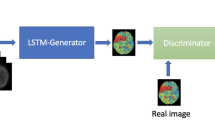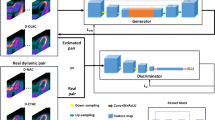Abstract
Objectives
To develop a generative adversarial network (GAN) model to improve image resolution of brain time-of-flight MR angiography (TOF-MRA) and to evaluate the image quality and diagnostic utility of the reconstructed images.
Methods
We included 180 patients who underwent 1-min low-resolution (LR) and 4-min high-resolution (routine) brain TOF-MRA scans. We used 50 patients’ datasets for training, 12 for quantitative image quality evaluation, and the rest for diagnostic validation. We modified a pix2pix GAN to suit TOF-MRA datasets and fine-tuned GAN-related parameters, including loss functions. Maximum intensity projection images were generated and compared using multi-scale structural similarity (MS-SSIM) and information theoretic-based statistic similarity measure (ISSM) index. Two radiologists scored vessels’ visibilities using a 5-point Likert scale. Finally, we evaluated sensitivities and specificities of GAN-MRA in depicting aneurysms, stenoses, and occlusions.
Results
The optimal model was achieved with a lambda of 1e5 and L1 + MS-SSIM loss. Image quality metrics for GAN-MRA were higher than those for LR-MRA (MS-SSIM, 0.87 vs. 0.73; ISSM, 0.60 vs. 0.35; p.adjusted < 0.001). Vessels’ visibility of GAN-MRA was superior to LR-MRA (rater A, 4.18 vs. 2.53; rater B, 4.61 vs. 2.65; p.adjusted < 0.001). In depicting vascular abnormalities, GAN-MRA showed comparable sensitivities and specificities, with greater sensitivity for aneurysm detection by one rater (93% vs. 84%, p < 0.05).
Conclusions
An optimized GAN could significantly improve the image quality and vessel visibility of low-resolution brain TOF-MRA with equivalent sensitivity and specificity in detecting aneurysms, stenoses, and occlusions.
Key Points
• GAN could significantly improve the image quality and vessel visualization of low-resolution brain MR angiography (MRA).
• With optimally adjusted training parameters, the GAN model did not degrade diagnostic performance by generating substantial false positives or false negatives.
• GAN could be a promising approach for obtaining higher resolution TOF-MRA from images scanned in a fraction of time.






Similar content being viewed by others
Abbreviations
- 3D TOF-MRA:
-
Three-dimensional time-of-flight magnetic resonance angiography
- FN:
-
False negative
- FP:
-
False positive
- GAN:
-
Generative adversarial network
- ISSM:
-
Information theoretic-based statistic similarity measure
- LR:
-
Low-resolution
- MS-SSIM:
-
Multi-scale structural similarity index measure
References
Nishimura DG (1990) Time-of-flight MR angiography. Magn Reson Med 14:194–201
Yan R, Zhang B, Wang L et al (2018) A comparison of contrast-free MRA at 3.0T in cases of intracranial aneurysms with or without subarachnoid hemorrhage. Clin Imaging 49:131–135
Zhang X, Cao YZ, Mu XH et al (2020) Highly accelerated compressed sensing time-of-flight magnetic resonance angiography may be reliable for diagnosing head and neck arterial steno-occlusive disease: a comparative study with digital subtraction angiography. Eur Radiol 30:3059–3065
Dong C, Loy CC, He K, Tang X (2014) Learning a Deep Convolutional Network for Image Super-Resolution. In: Computer Vision – ECCV 2014. Springer International Publishing, pp 184–199
Kim J, Lee JK, Lee KM (2016) Deeply-recursive convolutional network for image super-resolution. In: 2016 IEEE Conference on Computer Vision and Pattern Recognition (CVPR). IEEE, pp 1637–1645
Lai W-S, Huang J-B, Ahuja N, Yang M-H (2017) Deep Laplacian pyramid networks for fast and accurate super-resolution. In: 2017 IEEE Conference on Computer Vision and Pattern Recognition (CVPR). IEEE, pp 5835–5843
Lim B, Son S, Kim H, et al (2017) Enhanced deep residual networks for single image super-resolution. In: 2017 IEEE Conference on Computer Vision and Pattern Recognition Workshops (CVPRW). IEEE, pp 1132–1140
Goodfellow IJ, Pouget-Abadie J, Mirza M et al (2014) Generative adversarial networks. arXiv:1406.2661 [stat.ML]. https://doi.org/10.48550/arXiv.1406.2661
Ledig C, Theis L, Huszár F et al (2017) Photo-realistic single image super-resolution using a generative adversarial network. In: 2017 IEEE Conference on Computer Vision and Pattern Recognition (CVPR). IEEE, pp 105–114
Gu Y, Zeng Z, Chen H et al (2020) MedSRGAN: medical images super-resolution using generative adversarial networks. Multimed Tools Appl 79:21815–21840
Kaji S, Kida S (2019) Overview of image-to-image translation by use of deep neural networks: denoising, super-resolution, modality conversion, and reconstruction in medical imaging. Radiol Phys Technol 12:235–248
Tan C, Zhu J, Lio’ P (2020) Arbitrary scale super-resolution for brain MRI images. Artificial Intelligence Applications and Innovations 583:165
Zhang H, Shinomiya Y, Yoshida S (2021) 3D MRI reconstruction based on 2D generative adversarial network super-resolution. Sensors 21. https://doi.org/10.3390/s21092978
Sanchez I, Vilaplana V (2018) Brain MRI super-resolution using 3D generative adversarial networks. arXiv:1812.11440 [cs.CV]. https://doi.org/10.48550/arXiv.1812.11440
Isola P, Zhu J-Y, Zhou T, Efros AA (2017) Image-to-image translation with conditional adversarial networks. In: Proceedings of the IEEE conference on computer vision and pattern recognition. pp 1125–1134
Wang Z, Simoncelli EP, Bovik A (2003) Multi-scale structural similarity for image quality assessment. In: The Thrity-Seventh Asilomar Conference on Signals, Systems & Computers. IEEE, pp 1398–1402
Loizides F, Schmidt B (2016) Positioning and power in academic publishing: players, agents and agendas: Proceedings of the 20th International Conference on Electronic Publishing. IOS Press
Chollet F (2015) Keras. In: GitHub. https://github.com/fchollet/keras
Aljanabi MA, Hussain ZM, Shnain NAA, Lu SF (2019) Design of a hybrid measure for image similarity: a statistical, algebraic, and information-theoretic approach. Eur J Remote Sens 52:2–15
Mason A, Rioux J, Clarke SE et al (2020) Comparison of objective image quality metrics to expert radiologists’ scoring of diagnostic quality of MR images. IEEE Trans Med Imaging 39:1064–1072
Zhai G, Min X (2020) Perceptual image quality assessment: a survey. Sci China Inf Sci 63:211301
Lucas A, Lopez-Tapia S, Molina R, Katsaggelos AK (2019) Generative adversarial networks and perceptual losses for video super-resolution. IEEE Trans Image Process 28:3312–3327
Ahn N, Kang B, Sohn K-A (2018) Fast, accurate, and lightweight super-resolution with cascading residual network. In: Proceedings of the European Conference on Computer Vision (ECCV), pp 252–268
Wang Z, Simoncelli EP, Bovik A (2003) Multi-scale structural similarity for image quality assessment. In: The Thrity-Seventh Asilomar Conference on Signals, Systems & Computers. IEEE, pp 1398–1402
Snell J, Ridgeway K, Liao R, et al (2017) Learning to generate images with perceptual similarity metrics. In: 2017 IEEE International Conference on Image Processing (ICIP), pp 4277–4281
Zhao H, Gallo O, Frosio I, Kautz J (2015) Loss Functions for Neural Networks for Image Processing. arXiv:1511.08861 [cs.CV]. https://doi.org/10.48550/arXiv.1511.08861
Wang J, Chen Y, Wu Y, et al (2020) Enhanced generative adversarial network for 3D brain MRI super-resolution. In: 2020 IEEE Winter Conference on Applications of Computer Vision (WACV), pp 3616–3625
Do H, Bourdon P, Helbert D et al (2021) 7T MRI super-resolution with generative adversarial network. IS&T Int Symp Electron Imaging 2021:106–106
Hagiwara A, Otsuka Y, Hori M et al (2019) Improving the quality of synthetic FLAIR images with deep learning using a conditional generative adversarial network for pixel-by-pixel image translation. AJNR Am J Neuroradiol 40:224–230
Küstner T, Munoz C, Psenicny A et al (2021) Deep-learning based super-resolution for 3D isotropic coronary MR angiography in less than a minute. Magn Reson Med 86:2837–2852
Acknowledgements
Krishna Pandu Wicaksono, MD, likes to thank the Indonesia Endowment Fund for Education (LPDP) for providing the scholarship for his doctoral study.
Funding
Not applicable.
Author information
Authors and Affiliations
Corresponding author
Ethics declarations
Guarantor
The scientific guarantor of this publication is Koji Fujimoto.
Conflict of interest
Four authors (Koji Fujimoto, Kanae Kawai Miyake, Hitomi Numamoto, and Tsuneo Saga) belong to an Industry-Academia collaboration department. Conflicts of interest for each author will be submitted to the editorial office.
Statistics and biometry
No complex statistical methods were necessary for this paper.
Informed consent
Since this was a retrospective study, written informed consent was waived from all subjects (patients) in this study.
Ethical approval
Institutional Review Board approval was obtained.
Methodology
• retrospective
• cross-sectional study
• performed at one institution
Additional information
Publisher’s note
Springer Nature remains neutral with regard to jurisdictional claims in published maps and institutional affiliations.
Supplementary Information
ESM 1
(DOCX 8013 kb)
Rights and permissions
Springer Nature or its licensor holds exclusive rights to this article under a publishing agreement with the author(s) or other rightsholder(s); author self-archiving of the accepted manuscript version of this article is solely governed by the terms of such publishing agreement and applicable law.
About this article
Cite this article
Wicaksono, K.P., Fujimoto, K., Fushimi, Y. et al. Super-resolution application of generative adversarial network on brain time-of-flight MR angiography: image quality and diagnostic utility evaluation. Eur Radiol 33, 936–946 (2023). https://doi.org/10.1007/s00330-022-09103-9
Received:
Revised:
Accepted:
Published:
Issue Date:
DOI: https://doi.org/10.1007/s00330-022-09103-9




